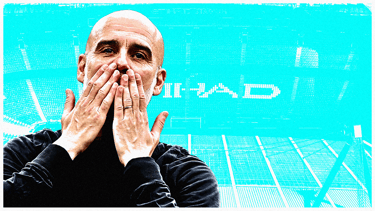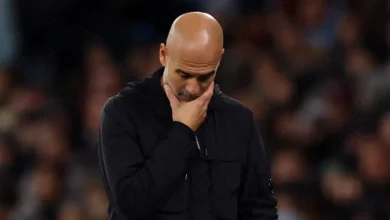Big blow for Man City as surgery could rule out player they now want to sign for four months

Manchester City’s ambitious summer transfer plans have encountered a significant obstacle that could reshape their goalkeeper strategy for the upcoming season. After successfully securing three high-profile signings in rapid succession during the early stages of the transfer window, Pep Guardiola’s side now faces a complex challenge in their pursuit of Barcelona’s Marc-Andre ter Stegen, with the German international potentially facing four months on the sidelines due to required back surgery.
The development represents a considerable setback for the Premier League champions, who have been quietly monitoring the goalkeeper situation at the Etihad Stadium amid growing uncertainty surrounding their current shot-stopping department. With Stefan Ortega’s future hanging in the balance and Ederson attracting serious interest from Turkish giants Galatasaray, City’s goalkeeping department could undergo dramatic changes before the transfer window closes.
City’s Transfer Window Success Stories
Manchester City’s summer has been marked by efficiency and strategic planning, characteristics that have become synonymous with the club’s approach under the guidance of director of football Txiki Begiristain. The club moved swiftly to address key areas of concern, bringing in three quality additions who are expected to make immediate impacts on Guardiola’s squad.
The early success in the transfer market had generated optimism that City could continue their seamless recruitment throughout the remainder of the window. However, the reality of modern football transfers has begun to present challenges that even the most well-organized clubs struggle to navigate effortlessly.
The Citizens’ approach this summer has been notably different from previous years, with the club appearing more proactive in addressing potential departures before they become problematic. This forward-thinking strategy has been evident in their pursuit of ter Stegen, which was initiated as a contingency plan rather than a reaction to an immediate crisis.
The Marc-Andre ter Stegen Situation
Marc-Andre ter Stegen has established himself as one of Europe’s premier goalkeepers since his arrival at Barcelona from Borussia Monchengladbach in 2014. The 33-year-old German international has been instrumental in Barcelona’s recent successes, including their Champions League triumph, and has consistently been praised by teammates and opponents alike for his shot-stopping ability and distribution skills.
Luis Suarez, the former Barcelona striker, has been particularly vocal in his praise of ter Stegen, describing him as “one of the most complete goalkeepers in world football.” Such endorsements have not gone unnoticed at the Etihad Stadium, where City’s scouting network has been closely monitoring the goalkeeper’s performances and contractual situation.
The interest in ter Stegen reflects Manchester City’s long-term planning approach. Rather than waiting for a crisis to emerge, the club has been identifying potential solutions to scenarios that might unfold during the transfer window. This proactive stance has served them well in previous summers and explains why ter Stegen emerged as a viable target despite Barcelona’s reluctance to sell key players.
The Injury Setback
The latest reports from Spanish publication SPORT have revealed the extent of ter Stegen’s current physical condition, painting a concerning picture for all parties involved. After returning to Barcelona’s training facilities following the summer break, the goalkeeper reportedly experienced “serious” back pain that prompted immediate medical attention.
The subsequent tests have apparently confirmed what Barcelona’s medical staff had feared – that ter Stegen requires surgical intervention to address the underlying issue. The procedure, should he decide to proceed with it, could potentially sideline him for up to four months, effectively ruling out any possibility of a summer transfer.
This development has forced both Manchester City and ter Stegen himself to reassess their respective positions. For City, it means returning to the drawing board in their search for goalkeeping reinforcement. For ter Stegen, it represents a significant professional setback at a crucial stage of his career, particularly given his international ambitions.
Impact on City’s Squad Planning
Manchester City’s squad composition presents ongoing challenges due to Premier League and UEFA regulations regarding homegrown players. Currently carrying 17 non-homegrown players, the club faces restrictions on new acquisitions unless they can facilitate departures. This limitation has become increasingly problematic as City seeks to maintain their competitive edge across multiple competitions.
The ter Stegen pursuit was viewed as part of a broader strategy to refresh the goalkeeping department while potentially freeing up resources elsewhere. Stefan Ortega’s uncertain future, as exclusively reported by Manchester City News, has created a domino effect that could influence several other transfer decisions.
Ortega’s assessment of his future at the Etihad reflects the competitive nature of City’s squad, where even quality players can find regular opportunities limited. His potential departure would create space for a high-profile addition like ter Stegen, but the German’s injury situation has complicated these calculations significantly.
The Ederson Factor
Ederson’s situation adds another layer of complexity to City’s goalkeeping conundrum. The Brazilian’s impressive performances since joining from Benfica have made him one of the most sought-after goalkeepers in European football. His unique combination of shot-stopping ability and exceptional distribution skills has revolutionized City’s approach to playing out from the back.
Galatasaray’s interest in Ederson represents a genuine threat to City’s stability between the posts. The Turkish club’s confidence in securing the Brazilian’s signature suggests they believe his wage demands can be met, something that could prove attractive to a player who has achieved significant success in England.
The potential departure of Ederson would transform City’s transfer priorities entirely. Rather than seeking a backup option or rotation player, they would need to identify a goalkeeper capable of maintaining the standards expected at the highest level of European football. This scenario makes the ter Stegen injury setback even more significant.
Alternative Options and Strategic Considerations
With ter Stegen potentially unavailable until the winter transfer window, Manchester City’s recruitment team must explore alternative options. The goalkeeper market in July presents both opportunities and challenges, with most top-tier shot-stoppers already settled at their respective clubs or subject to prohibitive valuations.
The timing of ter Stegen’s injury diagnosis also complicates Barcelona’s own planning. Hansi Flick’s side had been open to discussions regarding the goalkeeper’s future, potentially viewing a summer sale as an opportunity to reinvest in other areas of the squad. However, the injury situation makes any departure virtually impossible, as stated in recent reports.
This development may force Barcelona to reconsider their own transfer strategy, potentially impacting other deals in the market. The interconnected nature of modern football transfers means that one significant setback can have ripple effects across multiple clubs and negotiations.
International Implications
Ter Stegen’s injury concerns extend beyond club football, with significant implications for his international career aspirations. The goalkeeper has made no secret of his desire to challenge Manuel Neuer for the Germany number one position ahead of the 2026 World Cup, a goal that requires consistent playing time and peak physical condition.
The potential four-month layoff could seriously damage ter Stegen’s World Cup ambitions, particularly given the competitive nature of international football and the limited opportunities to impress national team selectors. At 33, every month away from competitive action becomes increasingly significant in maintaining the physical and mental sharpness required at the highest level.
Germany’s goalkeeping department has been dominated by Neuer for over a decade, but ter Stegen’s consistent performances at club level had positioned him as a legitimate challenger. The injury setback may provide opportunities for other German goalkeepers to stake their claims for national team inclusion.
Financial Implications
The transfer market operates on tight timelines and financial considerations, both of which have been disrupted by ter Stegen’s injury situation. Barcelona had potentially viewed a summer sale as an opportunity to balance their books while funding other acquisitions. The inability to complete such a transaction may force them to explore alternative revenue streams or reconsider other planned investments.
For Manchester City, the financial implications are equally significant. The club had likely allocated resources for a goalkeeping acquisition, funds that may now need to be redirected toward alternative targets or retained for the winter window. The Premier League’s financial regulations add another layer of complexity to these calculations.
The uncertainty surrounding ter Stegen’s availability also impacts his market value. A four-month injury layoff at his age could influence future transfer valuations, particularly if the recovery process encounters complications or extended rehabilitation periods.
Looking Ahead
As Manchester City navigates this unexpected development, several scenarios remain possible. The club could pursue alternative goalkeeper targets currently available in the market, though options at ter Stegen’s level are limited. Alternatively, they might choose to maintain faith in their current options while monitoring the situation ahead of the winter transfer window.
The decision-making process will likely depend on developments regarding Ederson and Ortega’s futures. Should both players remain at the club, the need for additional goalkeeping reinforcement becomes less urgent. However, if either departs, City may be forced to explore less ideal alternatives in the current market.
Barcelona’s position has also shifted dramatically due to the injury situation. Rather than having flexibility in their transfer planning, they now face the prospect of entering the new season with an injured first-choice goalkeeper and limited options for adequate replacement.
The next few weeks will be crucial in determining how this situation unfolds. Ter Stegen’s final decision regarding surgery will influence not only his own career trajectory but also the transfer strategies of multiple high-profile clubs.
Conclusion
Manchester City’s pursuit of Marc-Andre ter Stegen exemplifies the unpredictable nature of modern football transfers. Despite careful planning and strategic thinking, unforeseen circumstances can quickly alter the landscape and force clubs to adapt their approaches.
The potential four-month injury layoff represents more than just a transfer setback for City – it highlights the delicate balance clubs must maintain in squad planning while navigating regulatory constraints and competitive pressures. As the summer transfer window progresses, City’s ability to adapt to this challenge will test the depth of their planning and the flexibility of their recruitment strategy.
For ter Stegen, the situation presents a career crossroads that will require careful consideration of both short-term recovery and long-term ambitions. The decisions made in the coming days could shape not only the remainder of his club career but also his international prospects heading toward the 2026 World Cup.
The football world will be watching closely as this situation develops, with implications extending far beyond the immediate parties involved. In an interconnected transfer market, one player’s injury can create opportunities and challenges across multiple clubs and leagues, demonstrating the complex web of relationships that define modern football.















